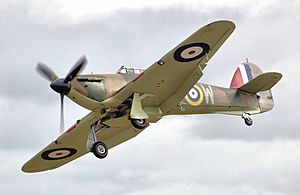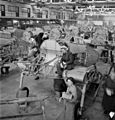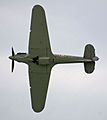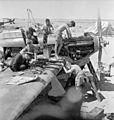Hawker Hurricane facts for kids
Quick facts for kids Hurricane |
|
|---|---|
 |
|
| Hurricane Mk I (R4118), which fought in the Battle of Britain | |
| Role | Fighter |
| National origin | United Kingdom |
| Manufacturer | Hawker Aircraft |
| Designer | Sydney Camm |
| First flight | 6 November 1935 |
| Introduction | 25 December 1937 |
| Primary users | Royal Air Force Royal Canadian Air Force |
| Produced | 1937–1944 |
| Number built | 14,583 |
| Variants | Hawker Hurricane variants |
The Hawker Hurricane was a very important British military aircraft during World War II. It was the main fighter plane used by the RAF during the famous Battle of Britain. While it was later joined and sometimes outshone by the faster Supermarine Spitfire, the Hurricane played a huge role in defending Britain. A special version called the Sea Hurricane was also used by the Fleet Air Arm from ships.
Contents
The Hurricane's Design and Features
The Hawker Hurricane was designed by Sydney Camm. It first flew on 6 November 1935. It was introduced to the RAF on Christmas Day in 1937.
A Strong and Simple Plane
The Hurricane was known for being very strong and easy to repair. Its body was made from metal tubes covered with fabric. This made it tough and able to take a lot of damage in a fight. It also meant that ground crews could fix it quickly. This was super important during battles when planes needed to get back in the air fast.
Powerful Weapons
Early Hurricanes had eight machine guns. These guns were placed in the wings. This gave the Hurricane a lot of firepower. It could shoot down enemy planes effectively. Later versions of the Hurricane were even fitted with cannons or rockets.
The Battle of Britain Hero
The Hawker Hurricane became a true hero during the Battle of Britain in 1940. This was a huge air battle fought over the skies of Britain. The RAF was defending against attacks from the German air force, the Luftwaffe.
Defending the Skies
More Hurricanes were available than Spitfires at the start of the battle. They carried out most of the attacks against German bombers. The Spitfires often focused on fighting the German fighter planes. This teamwork was key to winning the battle. The Hurricane's strong build meant it could often survive hits that might bring down other planes.
A Vital Role
The Hurricane's ability to absorb damage and its powerful guns made it perfect for attacking large groups of bombers. Many pilots became aces flying the Hurricane. An ace is a pilot who has shot down five or more enemy aircraft. The Battle of Britain was a turning point in World War II. The Hurricane's role in it was absolutely vital.
Life After the Battle of Britain
Even after the Battle of Britain, the Hurricane continued to serve. It was used in many different ways and in different parts of the world.
New Roles for the Hurricane
- Night Fighter: Some Hurricanes were changed to fly at night. They helped protect cities from night bombing raids.
- Ground Attack: Later versions were used to attack targets on the ground. They were fitted with bombs or rockets. These planes were very effective in supporting ground troops.
- Naval Service: The Sea Hurricane was a special version. It could take off from and land on aircraft carriers. These planes protected convoys of ships from enemy attacks at sea.
- Other Fronts: Hurricanes fought in North Africa, the Soviet Union, and Asia. They proved to be tough and reliable in many different climates.
Building the Hurricanes
A huge number of Hurricanes were built. Over 14,500 of these planes were made between 1937 and 1944. They were built by several companies, not just Hawker Aircraft. This massive production effort helped ensure the RAF had enough planes to fight the war.
Images for kids
-
Underside view of R4118, a preserved Hurricane from the Battle of Britain
-
Personnel of 85 Squadron next to a Hurricane I, Lille, Seclin, France, on 10 May 1940
-
Hurricane Mk I of the 46 Squadron during the Norwegian campaign, May 1940. This aircraft was abandoned in Norway.
-
Hurricane I of 1 Squadron being refuelled at Vassincourt, France
-
Mechanics servicing the engine of a Hurricane I of 501 Squadron at No. 1 Repair Centre, Reims, Champagne, France
-
Hurricane I of 1 Squadron flown by Plt Off A.V. Clowes.
-
Groundcrew refuelling a Hurricane Mk I of 32 Squadron, RAF Biggin Hill, Bromley, London, August 1940
-
Wartime colour photo of Hurricane IIC BE500 flown by Sqn Ldr Denis Smallwood of 87 Squadron in the RDM2 ("Special Night") scheme and used on intruder operations 1941–1942.
-
Maintenance work being carried out on a Hurricane of 274 Squadron during the siege of Tobruk
-
Preserved Sea Hurricane of the Fleet Air Arm.
-
The last of the 14,583 Hurricanes built, s/n PZ865. A Mk IIc version, originally known as "The Last of the Many" and owned by Hawker, this aircraft is now flown by the Battle of Britain Memorial Flight.
-
A Hawker Hurricane on display at the National Air and Space Museum's Udvar-Hazy Center of the Smithsonian Institution
See also
 In Spanish: Hawker Hurricane para niños
In Spanish: Hawker Hurricane para niños





























